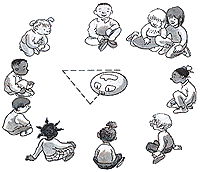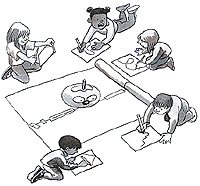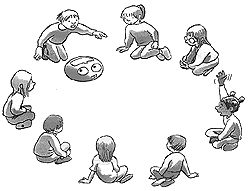
|
Feedback Form
| Summary | Basic activities | Forwards and backwards | Turning | Roamer Music |
 |
1
Sit the children in a circle, place Roamer in the centre and ask them
to watch what Roamer does. Turn Roamer on and press GO.
 Once Roamer
has performed ask the children to describe its actions. "Which way did
Roamer go first?" "How far?" "Which way did Roamer turn?" "How far did
it turn?" "Were all the notes the same?" "Were they the same length?"
"How long did Roamer stop for?"
Once Roamer
has performed ask the children to describe its actions. "Which way did
Roamer go first?" "How far?" "Which way did Roamer turn?" "How far did
it turn?" "Were all the notes the same?" "Were they the same length?"
"How long did Roamer stop for?"
This activity develops language in a mathematical context. Children are learning to describe movement in a variety or ways and are being introduced to the idea of measurement. Everything can be measured and the units chosen can be quite arbitrary or standard. It is also a valuable activity in getting children to record mentally and then talk about what they have seen.

2
Press GO again so the children can confirm what they have seen. Give each
child a piece of paper and ask them to draw the route that they think
Roamer is following.
 Put a pen down
the centre of Roamer, press GO, and watch Roamer draw its trail. (Note:
place card under Roamer for it to draw on.) See how it compares with the
drawings the children have done.
Put a pen down
the centre of Roamer, press GO, and watch Roamer draw its trail. (Note:
place card under Roamer for it to draw on.) See how it compares with the
drawings the children have done.
Mentally moving information from one place to another is an important skill for children to learn (eg. looking up at a blackboard and then writing on paper). This is quite a difficult activity for some children so you may want to let them draw their diagram as Roamer draws hers. It is the beginning of hand-eye coordination and understanding shape and space.

3
Place Roamer in front of one child and ask who they think Roamer will
visit when they press GO. You could use the shape that Roamer has drawn
as a prompt if needed.

This activity concentrates on estimating direction and measurement. Repeat this activity many times.
